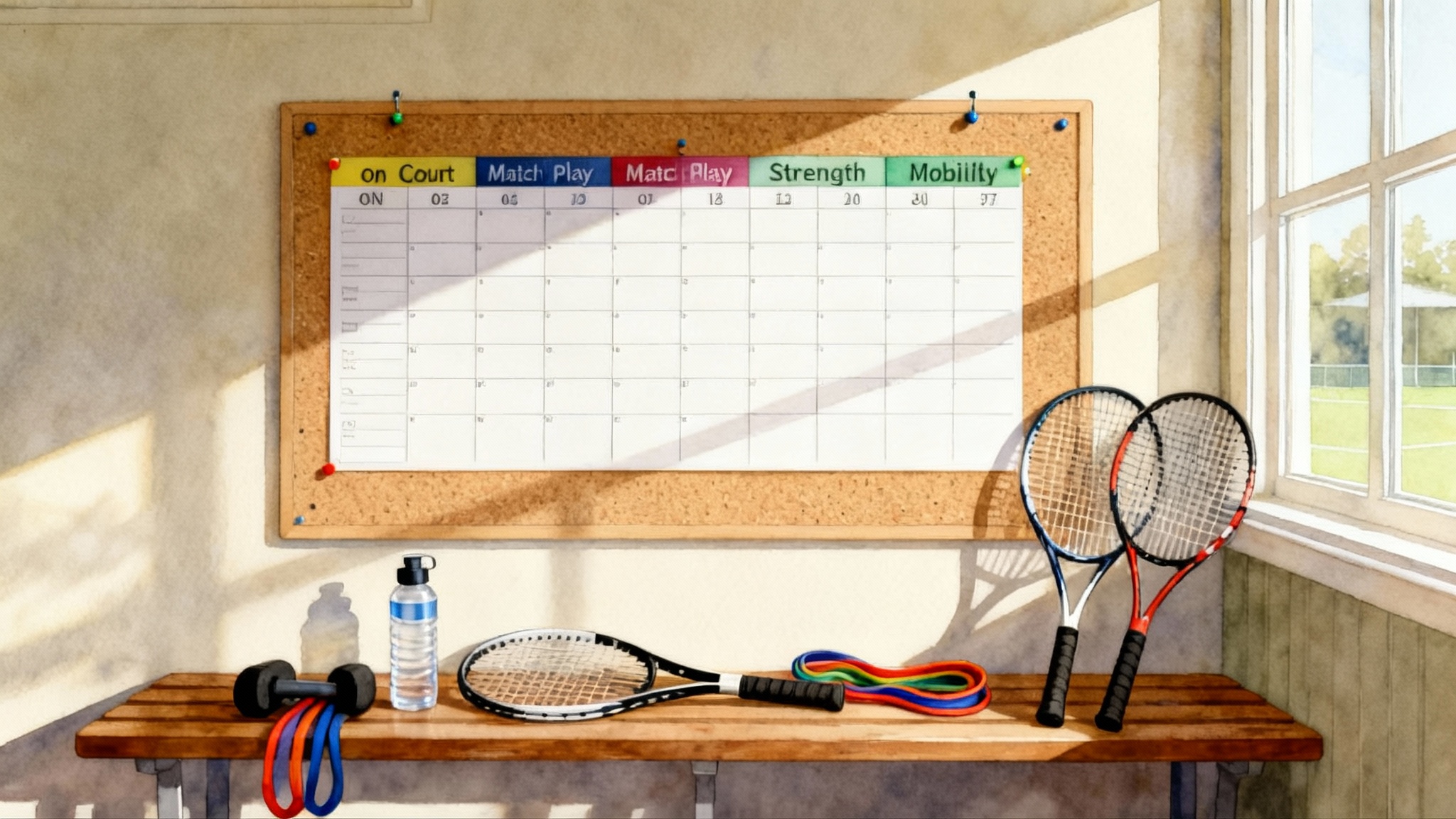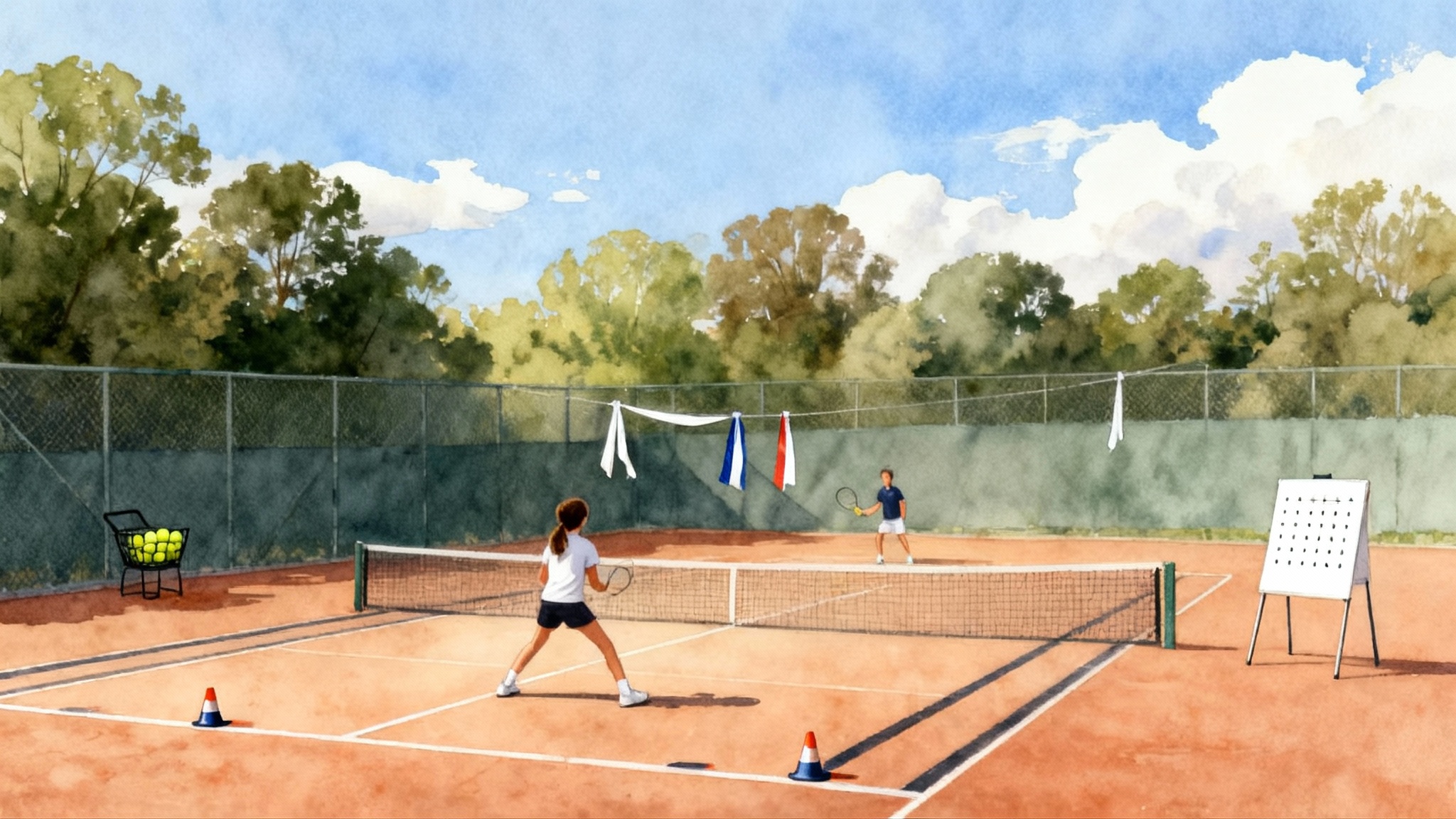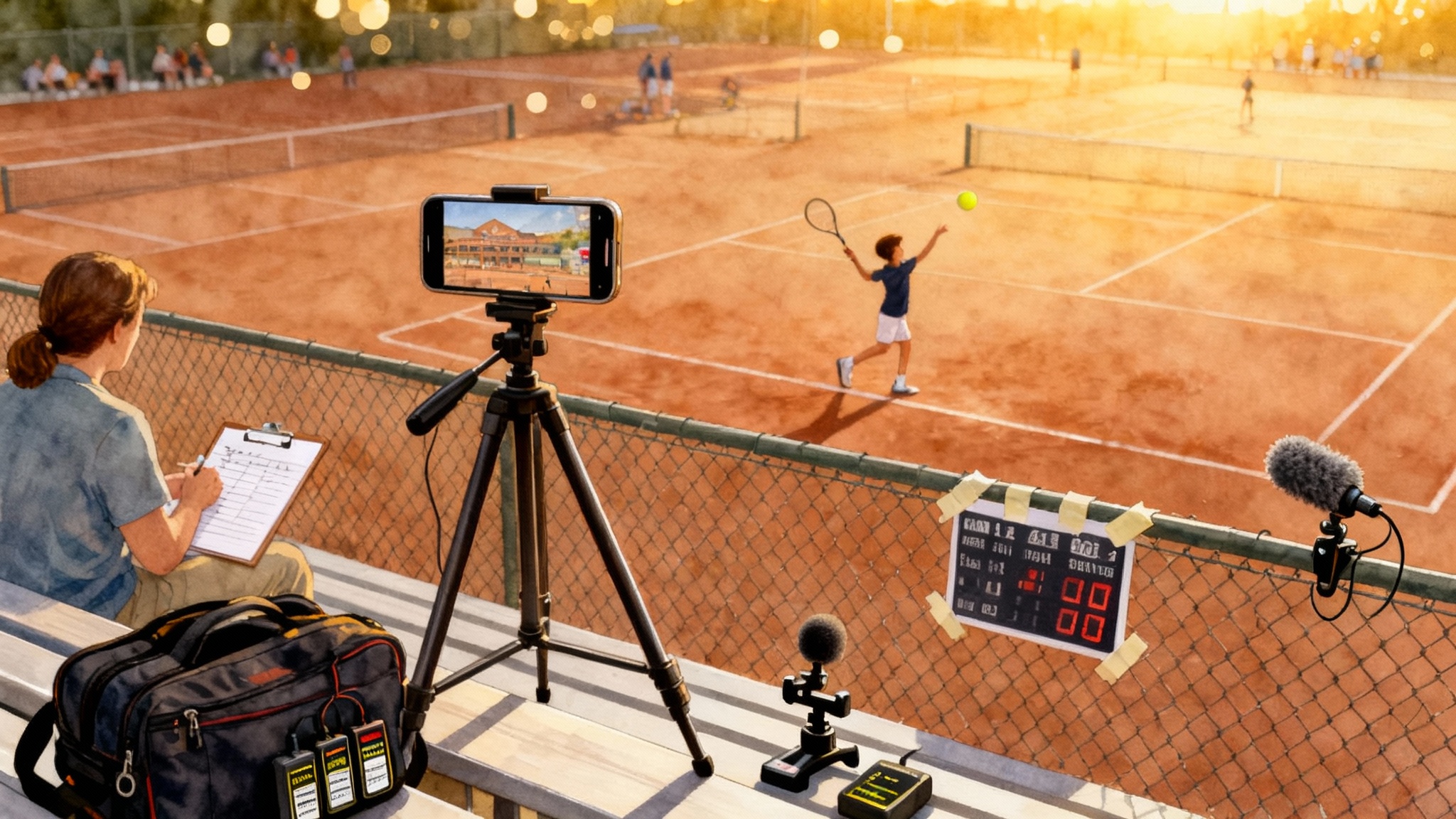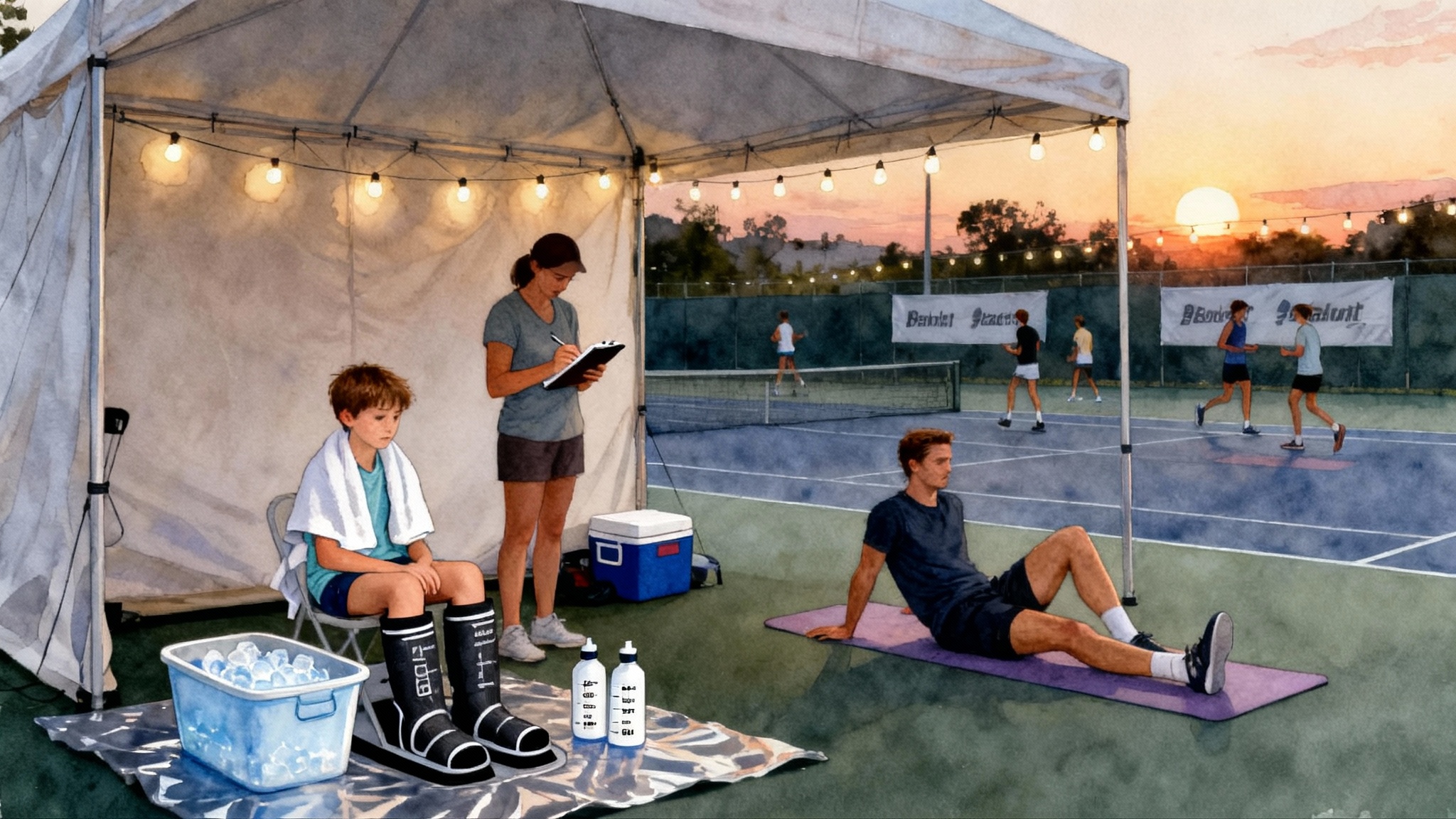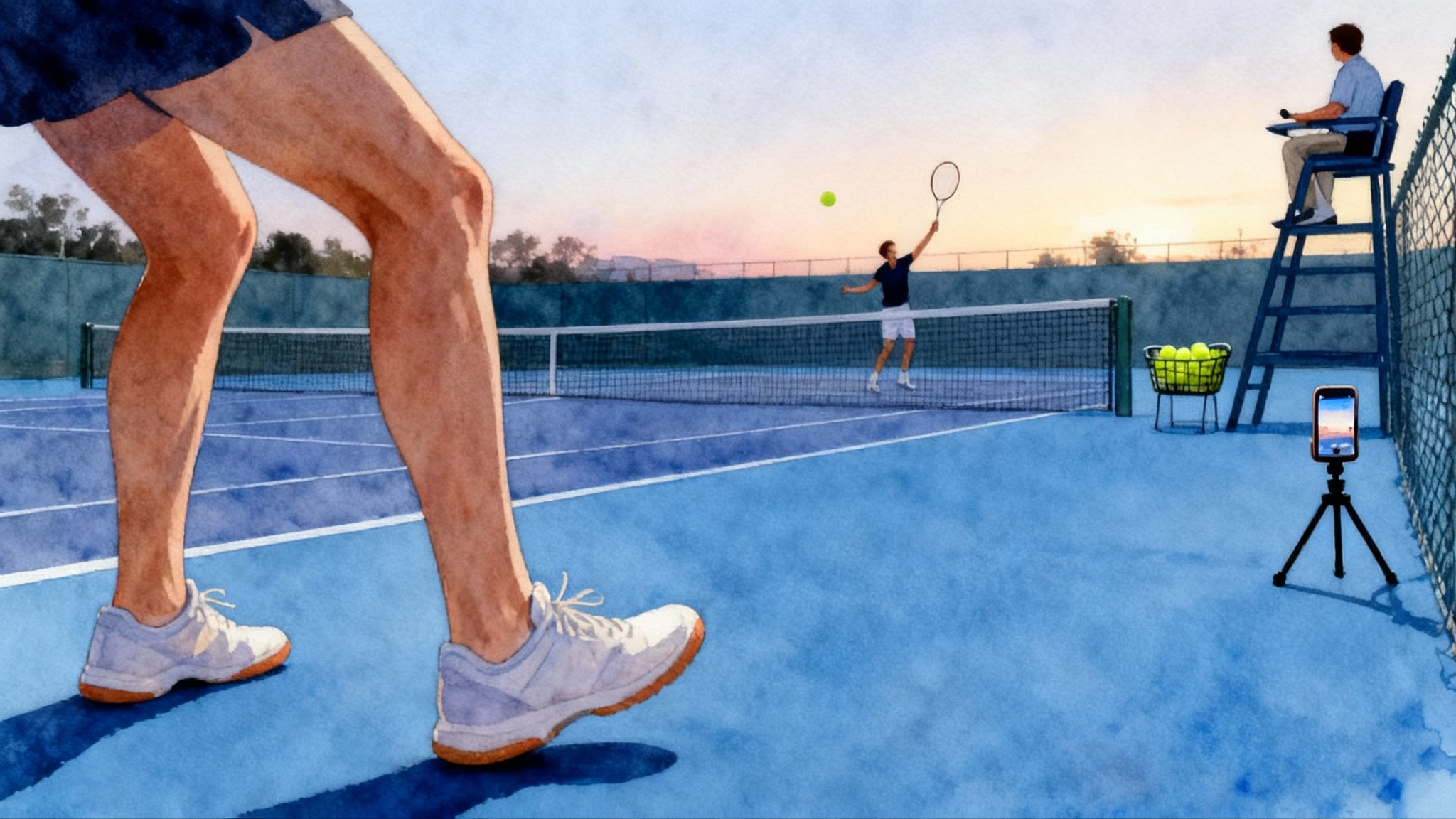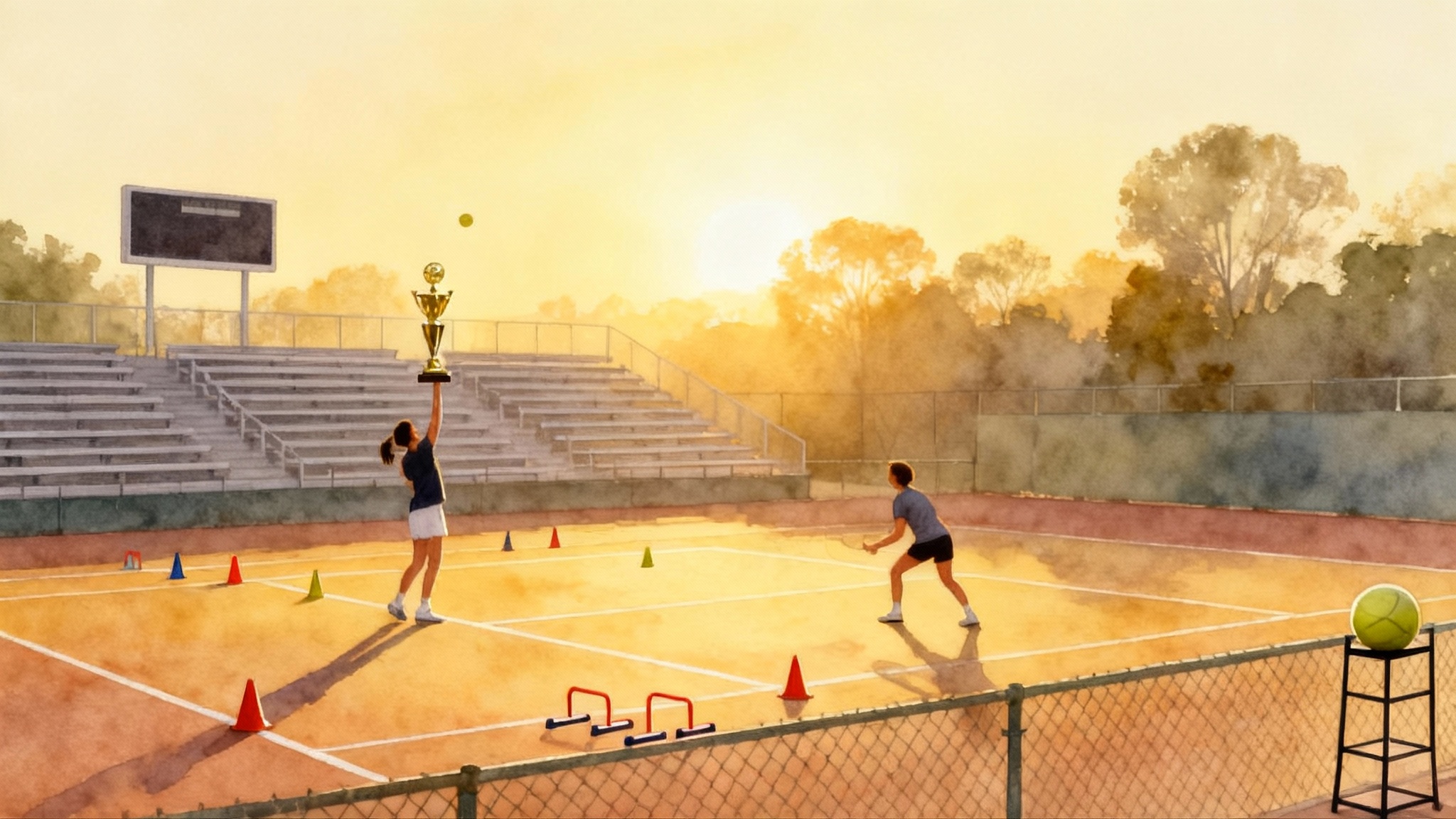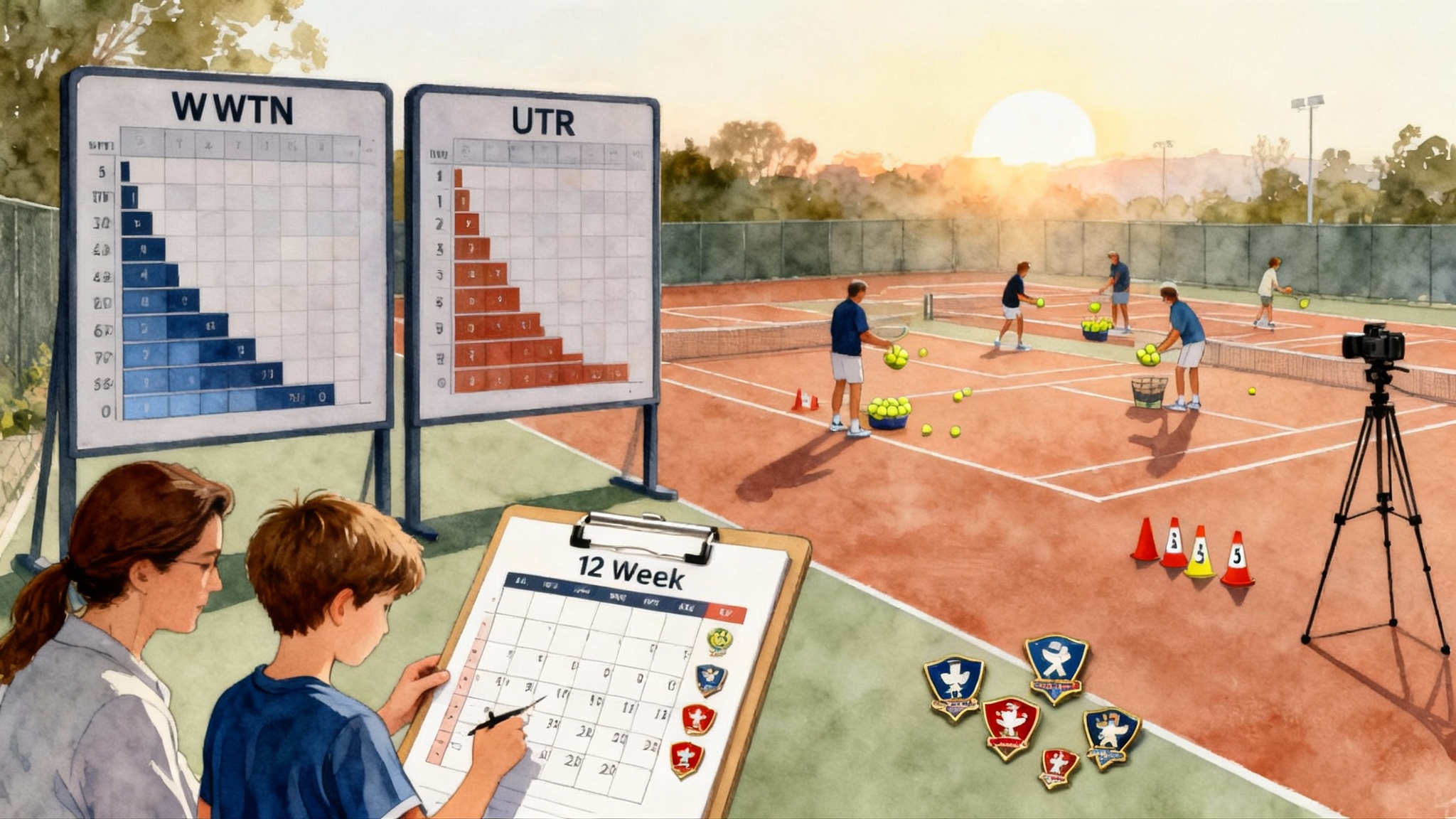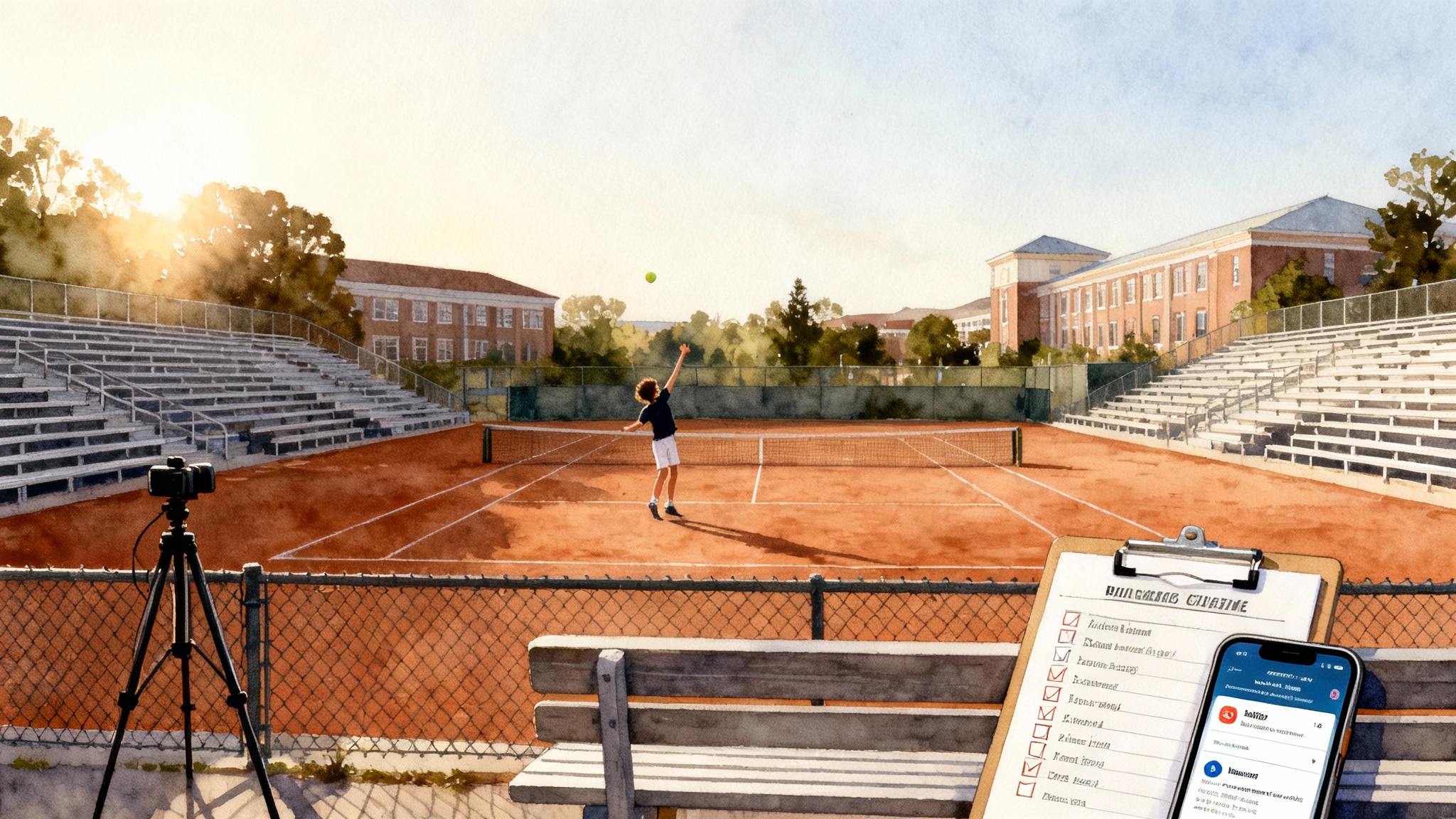College Doubles Blueprint: 8 Skills to Win More Points
Turn college-style doubles into a trainable checklist. Master serve targets, first volleys, deep returns, proactive poaching, I and Aussie signals, transition footwork, overhead coverage, and between-point talk with clear drills and metrics.
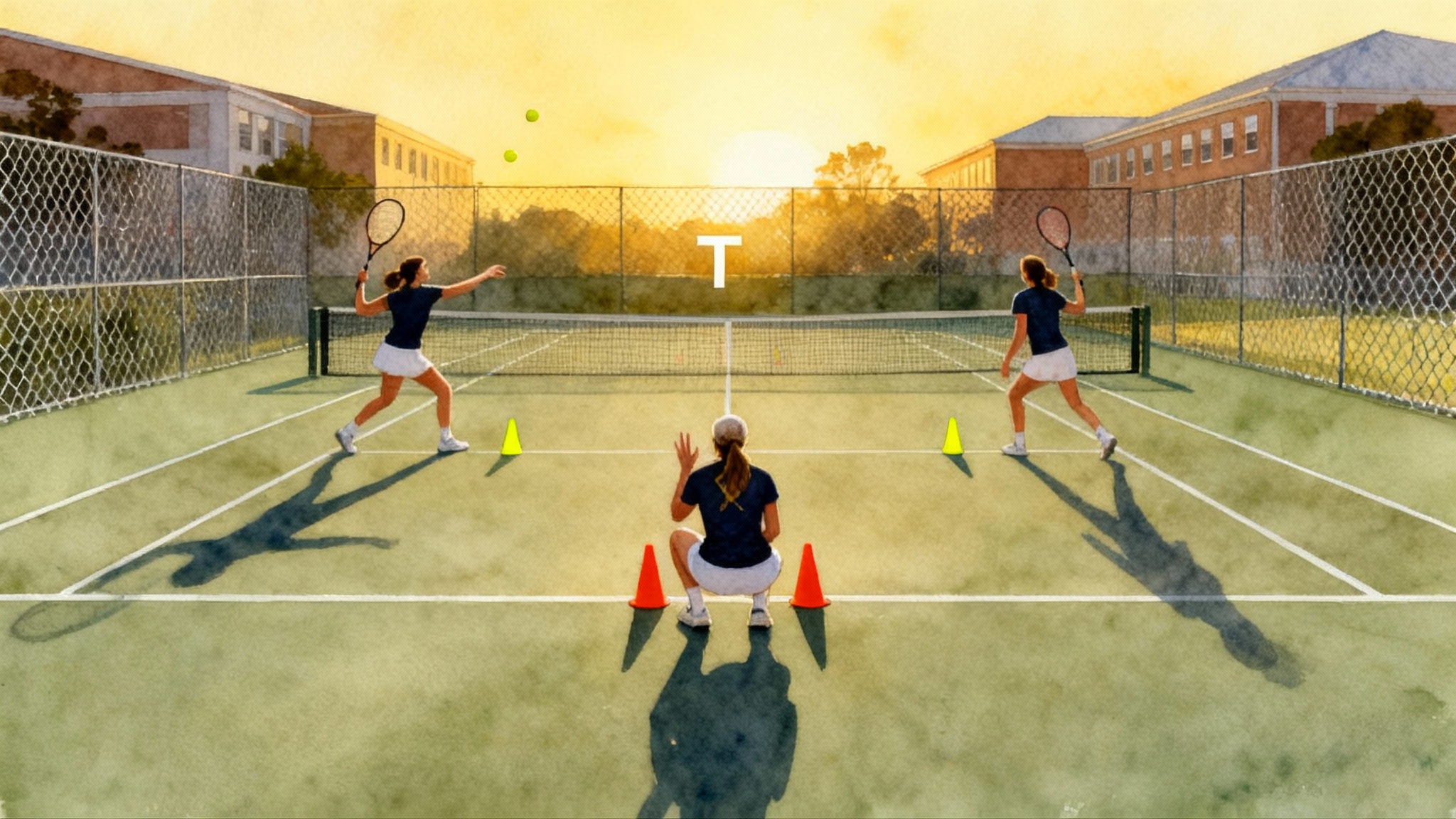
Why college doubles feels different
College doubles rewards clarity, pace, and decisive movement. The format puts a premium on quick starts, clean first shots, and partners who talk with a plan. In many dual matches the doubles point is played in short sets with no-ad scoring, which means momentum can flip in one or two points. If you want a primer on the structure most programs follow, scan the official ITA dual match format. The takeaway is simple: you cannot wait for rhythm, you must impose it.
This guide translates college-style doubles into eight concrete skills that coaches recruit for and that adults can sharpen too. Each skill includes at-home drills for parents, on-court progressions for coaches, and simple benchmarks so you can keep score on the things that actually win the point.
The blueprint: 8 skills coaches recruit for
1) Serve targets that set up the net player
What it is: Serving to a called zone that gives your partner an early play. Think T, body, or wide, with a plan for the next ball. The goal is not just a first serve in; it is a first serve that limits the returner’s angle and invites your partner to move.
Why it matters: When servers hit the planned zone, the return crosscourt lane narrows. The net player can take a step across, shrink time, and poach on contact. Consistent targets also reduce double faults because you are aiming with purpose.
At-home drill for parents
- Tape three rectangles inside the service box on your driveway or garage wall and shadow-serve into those windows for five minutes. Focus on the same toss height and a balanced landing.
- Do 3 sets of 10 shadow serves to each zone. Call the zone out loud before each rep to build the call-and-commit habit.
On-court progressions for coaches
- Cone challenge: 20 first serves to each zone per side. Count a serve-to-zone only if the ball lands in the correct third and reaches the back fence or baseline depth.
- Pair with a poach: server calls “T plus go” or “body plus hold.” Net player must act decisively by the returner’s contact.
Benchmarks
- First serve percentage: 60 percent or better.
- Serve-to-zone percentage: 65 percent in practice, 55 percent in matches for juniors; 70 percent and 60 percent for advanced adults.
- Free or neutral points created: at least 50 percent of service points where your partner can take one step forward without fear.
2) First-volley quality under pressure
What it is: The first volley after serve or approach that keeps you on offense. The big three qualities are depth, height, and direction to the safe lane.
Why it matters: College doubles is a race to control the middle. A first volley struck chest-high, directed deep middle or into the open lane, buys time for your partner to squeeze the center and hunt.
At-home drill for parents
- Wall volley ladder: mark a line on a wall around net height. Volley 20 in a row keeping the ball under the line. Then step back one stride and repeat. Focus on a quiet head and firm wrist.
- Soft hands set: 3 sets of 15 forehand and 15 backhand catch-then-punch reps with a partner tossing from 10 feet.
On-court progressions for coaches
- Serve, split, stick: server must split at the service line and play one controlled first volley deep middle before the point becomes live.
- Traffic-cone lanes: place two cones in the back half of the court’s middle. First volley must finish past the service line and between cones to earn the right to attack down the line on the next ball.
Benchmarks
- First-volley-in percentage: 80 percent in practice, 70 percent in matches.
- Deep first volley percentage: 60 percent landing beyond the service line.
- Neutralize errors: fewer than 2 first-volley errors per set on your serve.
3) Deep and low returns
What it is: A return that travels crosscourt, either deep to the baseline or low to the server’s feet, with enough shape to resist the net player’s reach.
Why it matters: The return is the returner’s serve. Deep and low forces the server up and the net player down. Both positions produce weaker balls you can attack. For a focused return block, use our return of serve plan.
At-home drill for parents
- Target window: hang a towel on a wall about knee height. From 15 feet, hit controlled mini-swings trying to pass just over the towel. Maintain the same swing path for 30 reps.
- Rhythm builder: drop feed to yourself and swing a compact return motion, focusing on early unit turn and contact in front. Do 3 sets of 12 on each side.
On-court progressions for coaches
- Return lanes: set a rope or tape two feet inside the baseline and an elastic cord across the net at strap height. Score only if the ball lands beyond the rope or travels below the cord.
- Poach pressure: live serve. Net player must fake or go on every ball. Returner’s goal is 70 percent in play while hitting through the crosscourt window.
Benchmarks
- Returns in play: 70 percent on first serves, 80 percent on second serves.
- Depth or height win: at least 50 percent of returns either past the service line or below net-strap height a racket length from the net.
- Forced errors drawn: at least 3 per set from the server or net player.
4) Proactive poaching and reads
What it is: The net player moves before the ball crosses the net, based on tells like toss direction, shoulder angle, and contact height. The move is timed to arrive as the ball passes the net, not after it lands.
Why it matters: A proactive poach steals time and removes the crosscourt. You do not need a winner. Touching the next ball with your strings often ends the point two shots later in your favor.
At-home drill for parents
- Mirror timing: one partner is the imaginary returner. Call “toss” and “hit.” The net player splits on “toss” and crosses on “hit” for 10 reps each side. Add a metronome at 60 beats per minute: split on the first beat, move on the second.
- Video a 20-second sequence from behind to see hips and shoulders. The head should stay level as the feet cross.
On-court progressions for coaches
- Shadow-to-live: two shadow poaches for rhythm, then a live feed you must intercept. Repeat ten times each direction.
- Go or hold game: serving team must either go or hold on every point. The net player calls the choice and commits early. Score one bonus point for any ball touched on a go.
Benchmarks
- Poach attempts per return game: 2 or more.
- Poach touch rate: 50 percent of attempts include racquet on ball.
- Poach conversion: 40 percent of touches end the point within two shots.
5) I-formation and Aussie-formation signals
What it is: Using altered formations and clear hand signals to shape the returner’s target. I-formation starts with the net player low at center. Aussie places the server and net player on the same side before serve.
Why it matters: Formations steal the favorite crosscourt lane and force indecision. They also give your net player a head start because the coverage plan is pre-agreed.
Simple signal code
- One finger: net player goes across after serve.
- Two fingers: net player fakes across and recovers.
- Closed fist: net player stays.
- Thumb left or right by the server: serve T or wide.
At-home drill for parents
- Couch signals: sit facing each other and rehearse the sequence: eye contact, signal behind the back, audible “yes,” then a quick plan phrase such as “T plus go.” Do 20 silent cycles, then 20 with a whisper plan.
On-court progressions for coaches
- Static I-formation: net player crouches on the center line. Server aims T. Net player goes on any ball that travels above net strap height.
- Live Aussie: play a short set where every serve is Aussie. Server covers open court after serve if the net player goes.
Benchmarks
- Run at least two I- or Aussie-formations per service game.
- Win 60 percent of points on alternative formations once serve-to-zone is above 60 percent.
- Zero missed signals in a set; both players must echo the plan before the serve.
6) Transition footwork from baseline to net
What it is: Clean split steps and directional steps that carry you forward after serve, return, or approach without reaching or backpedaling.
Why it matters: College doubles rewards the team that arrives first to the middle. Footwork is the vehicle. Late feet create high volleys for the opponent. For a quick fix, see split-step timing made simple.
At-home drill for parents
- Figure-8 cones: two cones eight feet apart. Shuffle, cross-step, and split at each cone for 30 seconds on, 30 seconds off. Three rounds.
- Jump rope bursts: 20 seconds on, 20 seconds off for five rounds. Emphasize a soft landing and quick ankle stiffness.
On-court progressions for coaches
- Serve and first split: after serve, player must split on or just before the returner’s contact at the service line. Coach calls “now” to train timing.
- Approach ladder: feed a short ball. Player approaches, splits at the service line, and plays a first volley to deep middle, then closes for the second volley.
Benchmarks
- Time from serve landing to split at service line: under 1.5 seconds for juniors and advanced adults.
- No backpedal rule: zero backpedals on lobs. Use crossover and drop step only.
- Three clean forward steps after serve or return before the first contact, measured for two games per set.
7) Overhead coverage and switching
What it is: Shared responsibility on lobs using an X-pattern. The player moving back takes the overhead, the partner slides diagonally forward to cover the middle, and both players use early “yours, mine, switch” calls.
Why it matters: Opponents will lob you when you poach well. Coverage that buys one more ball keeps your net pressure credible.
At-home drill for parents
- Medicine ball overheads: with a light ball, practice the step-back, shoulder turn, and overhead throw for 3 sets of 10, focusing on the non-hitting hand up and eyes under the ball.
- Drop-step rehearsal: three quick drop steps, then a side shuffle. Repeat ten times each side.
On-court progressions for coaches
- Lob chute: coach lobs alternately to each side. The nearest player must call early and hit a controlled overhead or bounce overhead to the open half; partner slides to middle.
- Two-ball test: after the first overhead, a second lob comes immediately. Team must recover shape before striking the second ball.
Benchmarks
- Overheads in play: 80 percent including bounce overheads.
- Second-overhead success: 70 percent of points won when you must hit two overheads in a row.
- Early call rate: 90 percent of lobs with a clear call before contact.
8) Between-point communication that drives a plan
What it is: A short routine between points to reset, choose a simple plan, and confirm roles.
Why it matters: Doubles breaks down when partners are quiet. A clear plan prevents hesitation and boosts first-strike execution.
At-home drill for parents
- Three-word plan cards: make index cards with sample plans like “T plus go,” “body and hold,” “wide then switch.” Practice rapid-fire calls. Ten cards, two times through.
- Breath and cue: two deep nasal inhales, one long exhale, then a keyword like “first volley deep.”
On-court progressions for coaches
- Five-second huddles: require a plan before every serve and return point. Penalize silent starts with a lost point in practice games.
- Energy audit: one player owns positive talk, the other owns plan calls for a three-game segment, then switch roles.
Benchmarks
- Zero silent points on serve.
- Plan confirmation time: under five seconds.
- Language standard: positive, neutral, and specific; no critiques until changeovers.
A weekly practice template that fits real life
These templates assume a school team or adult league with four to five sessions per week plus one match. Adjust minutes as needed.
90-minute team session template
- Warm up, 10 minutes: dynamic movement, short court, and four minutes of split-step timing with clap cues.
- Serve targets, 15 minutes: 60 balls, call the zone before each serve; net player practices first step on returner’s contact.
- First-volley ladder, 15 minutes: serve, split, stick deep middle; then live point to four.
- Returns under pressure, 15 minutes: return lanes with poach fakes every ball.
- Poach and read circuits, 15 minutes: shadow-to-live and go or hold game.
- Formation reps, 10 minutes: two I-formation and two Aussie games to four points per team.
- Overhead coverage, 5 minutes: lob chute with early calls.
- Clutch game, 5 minutes: no-ad points starting 30 all. Partners must huddle each point.
45-minute home session template
- Shadow serves to taped zones, 10 minutes.
- Wall volleys under a low line, 8 minutes.
- Return swing mechanics off drop feeds, 8 minutes.
- Figure-8 footwork with jump rope, 10 minutes.
- Signal and plan rehearsal, 9 minutes.
Microcycle example for six days
- Monday: serve targets and first volleys; formation signals.
- Tuesday: returns and poach reads; overhead coverage.
- Wednesday: transition footwork; short set play with no-ad scoring.
- Thursday: serve-plus-one patterns; return depth games.
- Friday: formations and special plays; clutch games to simulate pressure.
- Saturday: match play; chart benchmarks.
A simple performance dashboard you can track
Keep a paper card or a phone note. Track two service games and two return games per set.
- Serve-to-zone percentage: green at 65 percent practice or 55 percent matches; yellow at 50 percent; red below 50 percent.
- First serve percentage: green at 60 percent or better.
- First-volley-in percentage: green at 80 percent practice or 70 percent matches.
- Return in play: green at 70 percent first serves and 80 percent second serves.
- Poach attempts per return game: green at 2 or more; yellow at 1; red at 0.
- Poach touch conversion: green at 40 percent of touches ending the point within two shots.
- Overheads in play: green at 80 percent; second-overhead win rate green at 70 percent.
- Communication: zero silent serve points; plan confirmation under five seconds.
If you coach a team, appoint a bench chart caller to record these for one pair per day. Rotate so everyone gets measured each week.
Match-day checklist for doubles
Before warmup
- Agree on one serving target and one formation you will use early.
- Confirm your signal code and who calls it.
- Choose two plan phrases you will use after every point.
- Pack two extra overgrips and a dry wristband; sweaty hands destroy first volleys.
During the five-minute warmup
- Practice two serves to each zone per side; net player rehearses first step.
- Hit four deep and low returns to set the shape.
- Trade two overheads with calls; rehearse the switch pattern.
During the set
- Huddle before every serve and return point.
- Start with body serves to force awkward contact, then expand to T or wide once you feel timing.
- Poach on a schedule: first point of the game, fourth point, and on any second serve you see early.
- Call formations on break points to disrupt patterns.
On changeovers
- Review two numbers: serve-to-zone percentage and poach attempts. Adjust only one thing at a time.
- Reset with the breath and cue. Keep cues short and specific.
Optional spotlight: a small-ratio, game-based model
Programs that win the doubles point in March and April built those skills in January. For a living example of small-ratio, game-based sessions in Southern California, look at Advantage Tennis Academy Irvine. The core idea is short courts, repeatable patterns, and an aggressive rep count at the net.
Sample 75-minute block you can emulate
- 10 minutes: serve-to-zone with a poach step every rep.
- 15 minutes: return lanes with the net player faking on every ball.
- 15 minutes: formation games, alternating I and Aussie every two points.
- 15 minutes: transition footwork into first volley ladders.
- 10 minutes: lob coverage with two overheads and a recovery split.
- 10 minutes: compressed no-ad set to six with the rule that the net player must touch the ball every point.
This structure forces decisions, creates predictable touches for the net player, and turns communication into a habit rather than a hope.
Bringing it all together
College-style doubles rewards the pair that decides first and moves first. That is good news because these are trainable choices. Aim to own your serve targets, your first volley, and the space over the net with proactive poaches. Layer in one or two formations, sharpen your transition feet, and agree on a fast between-point routine. Then keep score on the things that matter. If your serve-to-zone percentage climbs and your poach attempts rise, the scoreboard will tell you the rest. The blueprint is simple. The work is specific. Start today and let the numbers lead you to the point that swings the match.
